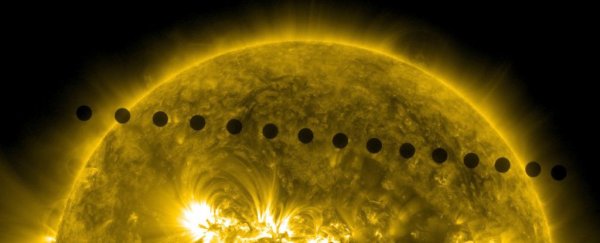When two bodies in space are close together enough, their gravity acts as a brake, slowing them until one's rotation 'locks' to match its orbit.
This tidal locking means that one side of the smaller body is permanently facing the larger – it's the reason why we only ever see one side of the Moon from Earth.
Earth's evil twin, Venus, lies close to the tidal locking threshold. So close that it very nearly could have been tidally locked to the Sun… yet it isn't.
It takes Venus 225 days to complete one orbit of the Sun – and 243 days to complete one rotation. What's more, unlike other planets, it rotates in the opposite direction to its orbit around the Sun.
It's a small difference, but a significant one. The one thing preventing Venus from locking fully is the planet's thick, tempestuous atmosphere, which whips around Venus in just four days: 60 times faster than the planet itself.
This, according to astrophysicist Stephen Kane of the University of California, Riverside, means that we need to pay much more attention to planetary atmospheres when studying not just Venus, but other planets orbiting distant stars.
"We think of the atmosphere as a thin, almost separate layer on top of a planet that has minimal interaction with the solid planet," Kane explains.
"Venus' powerful atmosphere teaches us that it's a much more integrated part of the planet that affects absolutely everything, even how fast the planet rotates."
Venus' atmosphere is pretty wild, thought to be one of the key characteristics that led to Earth and Venus – so similar in many other ways – becoming such very different worlds.
This is a puzzle that planetary scientists would love to solve, since it means the difference between a lush, habitable world (Earth) and a toxic, acidic hellscape (Venus).
On Venus, the insanely fast-moving atmosphere – due to the phenomenon of superrotation – results in winds higher than 400 kilometers per hour (around 250 miles per hour).
This superrotation causes the atmosphere to drag on the planetary surface – the result of which seems to be a slowing of the planet's rotation, as well as countering the grip of the Sun's gravity and preventing tidal locking.
The slow, retrograde rotation means that a single day on Venus, from sunrise to sunset, lasts around 117 days. The thick, toxic atmosphere traps most of the heat of the Sun: only 3 percent of incident sunlight reaches the surface, meaning that the rest is absorbed by the atmosphere.
The result is that Venus has the hottest surface of any body in the Solar System, bar the Sun, averaging around 482 degrees Celsius (900 Fahrenheit).
"It's incredibly alien, a wildly different experience than being on Earth," Kane says. "Standing on the surface of Venus would be like standing at the bottom of a very hot ocean. You couldn't breathe on it."
Because the atmosphere traps the solar energy, Venus just retains heat: a runaway greenhouse effect. We don't know what role being tidally locked might play in contributing to this runaway greenhouse effect, but studying Venus might yield some clues.
Most of the exoplanets we find are very close to their host stars; the tools we use to search for them are much better at finding close worlds. Many of these worlds would, therefore, be tidally locked.
Since a planet with a runaway greenhouse effect is inhospitable to life as we know it, figuring out how tidal locking impacts habitability could help us identify habitable worlds orbiting other stars.
When looking for habitable exoplanets, one of the things astronomers look for is roughly Earth-sized objects. But just being Earth-sized is unlikely to be sufficient.
Venus is more-or-less Earth-sized, and yet any Earth organisms trying to live there wouldn't be able to survive. Simply using Earth as a model for exoplanets, even tidally locked ones, might not yield accurate results.
"Venus is our opportunity to get these models correct, so we can properly understand the surface environments of planets around other stars," Kane says.
"We aren't doing a good job of considering this right now. We're mostly using Earth-type models to interpret the properties of exoplanets. Venus is waving both arms around saying, 'look over here!'"
Venus, he says, is a tool right here in our own Solar System that we can use to try to understand the climates of alien worlds.
The research has been published in Nature Astronomy.
